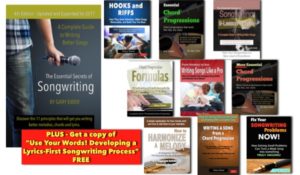In today’s pop music world, songs are getting shorter. Back in the ’50s and ’60s, most songs were under three minutes in length. “Lonely Boy“, recorded by Paul Anka in 1959, was 2’30”, and that was typical. Starting in the later ’60s and into the ’70s there was a slow increase in the length of a pop song. “Come and Get Your Love“, recorded by Redbone in 1974, is 3’30”.
By the 90s it wasn’t unusual for hit songs to be closer to four minutes in length, and often longer. Sinead O’Connor’s “Nothing Compares to You” from 1990, is a little over 5’00”, and Whitney Houston’s version of Dolly Parton’s “I Will Always Love You”, released in 1993, is 4’34”.
 Time to fix what’s ailing your songs. Read “Fix Your Songwriting Problems – NOW!” – It’s part of “The Essential Secrets of Songwriting 10-eBook Bundle” – Or get it separately.
Time to fix what’s ailing your songs. Read “Fix Your Songwriting Problems – NOW!” – It’s part of “The Essential Secrets of Songwriting 10-eBook Bundle” – Or get it separately.
But today, the length of a song is retreating back to what you’d typically find in the early 60s: often less than three minutes in length. The reason probably has more to do with money than with art; getting to the chorus quickly means making a shorter song, which means they can click on to the next song more quickly, increasing streaming revenue.
If you want to read more about this, there’s a good, concise article here from October 2019 on the InsideHook website: “Yes, Pop Songs Are Getting a Lot Shorter. Here’s Why.”
The extra length of longer pop songs in the 70s to 90s often came down to a at least two factors:
- Longer intros and/or outros.
- Inclusion of more optional sections. (You didn’t see a lot of pop songs from the 1950s with pre-chorus sections, and bridges were literally a middle-8… rarely longer than eight bars, and often shorter.)
Most of the songs on the Billboard Hot 100 this week (week of January 16, 2021) are between 2’30” and 3’30”. The longest song is “Laugh Now Cry Later” (Drake Featuring Lil Durk), but while it’s 4’22”, the last minute of it is a long outro fade.
Taking Streaming Revenue and Other Similar Issues Out of the Picture
Let’s assume for the moment that you’re more interested in writing a song that shows you as an artist, and ot overly concerned about streaming revenue. How long can a good pop song be?
My belief is that songs in the pop genres are still going to be too long if they go much over 4 minutes in length, if you assume that you’re going to use standard pop forms. In other words, if your songs use a typical verse-chorus-bridge structure, there’s not much opportunity to make the song longer.
There are longer pop songs, but there are reasons for the extra length that are easily noticeable. “Hotel California” is six-and-a-half minutes in length, but the final more than two minutes is the excellent guitar duet outro.
Other songs have long instrumental intros (“Bloody Well Right” – Supertramp), and other songs use a long list of non-traditional song sections, like “Bohemian Rhapsody“.
Experimenting Beyond Five Minutes
If you stick with standard pop song formats, going beyond five minutes in length (or even four minutes) brings you face to face with several problems, all relating to the fact that you need too many verses and choruses, and the song becomes boring to the listener.
If you want to experiment with songs that go longer, the best way to do that is to modify the form of your song. Simply repeating verses and choruses is too risky.
Modifying the form means bringing in optional sections that do any or all of the following:
- change key;
- change tempo;
- communicate a more elaborate story through a more involved lyric;
- change instrumentation.
The key to a longer song is the use of contrast and variation. As with shorter songs, you need to keep changing things for the listener. Listen to some progressive rock from the 70s if you want to hear good examples of what this might ultimately sound like. “And You And I” by Yes (10’07”) is a great example. It has many sections, all related by musical motifs, but very sectional, full of contrasts all meant to keep people listening.
All that really remains to be discussed is why. What will a longer song achieve for you? Throughout music history, going back to the beginnings of orchestral music in the early 1600s, there was really only one good reason for writing a longer musical work, and that is: to more fully develop your musical ideas.
Since any good song is a musical journey, the longer song needs to be the achievement of a more interesting musical journey. And as always, you’ll know you’ve achieved that goal if your audience stays with you.
 Written by Gary Ewer. Follow Gary on Twitter.
Written by Gary Ewer. Follow Gary on Twitter.
 The perfect combination: “The Essential Secrets of Songwriting 10-eBook Bundle” and a Study Guide! Dig into the songwriting manuals that thousands of songwriters are using to polish their technique, complete with a study guide to show you how to progress through the materials. Comes with an 11th FREE ebook: “Use Your Words! Developing a Lyrics-First Songwriting Process.”
The perfect combination: “The Essential Secrets of Songwriting 10-eBook Bundle” and a Study Guide! Dig into the songwriting manuals that thousands of songwriters are using to polish their technique, complete with a study guide to show you how to progress through the materials. Comes with an 11th FREE ebook: “Use Your Words! Developing a Lyrics-First Songwriting Process.”










